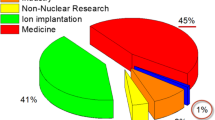Abstract
Objective
This study is aimed at optimizing the parameters of a dual-harmonic RF system which will be used in CSNS-II to have a larger bunching factor and less particle losing to decrease the space charge effect.
Methods
By studying the synchrotron equation of motion in a double RF system, some features of the bunch are quantized. The normalized bucket area should be constant, the injection condition should be satisfied, and larger bunching factor is preferred during the cycle period. With these ideas, three objective functions are proposed. Particle swarm optimization (PSO) method is employed to search the optimal solution.
Results
There is less particle loss in the simulation with the optimized parameters. The growth rate of the transverse emittance is smaller after the optimization. The bunch can keep a larger bunching factor which is very useful to decrease the space charge force.
Conclusion
The parameters of the dual-harmonic RF system are optimized with swarm optimization method. This study provides a general method to optimize the similar system, especially for an accelerator.







Similar content being viewed by others
Change history
13 March 2018
The original version of these four articles as below unfortunately contained a mistake. The category “Review” was incorrect. The correct category is “Original Paper”.
References
CSNS Accelerator Team, Conceptual design on Chinese spallation neutron source-accelerators (2004). IHEP-CSNS-Report/2004-01E (in Chinese)
C. Prior, Studies of dual harmonic acceleration in ISIS. ICANS XII, RAL Report 94025, A11 (1994)
J.M. Baillod, L. Magnani, G. Nassibian et al., IEEE Trans. Nucl. Sci. 30, 3499–3501 (1983)
F. Tamura, M. Yamamoto, M. Yoshii et al., Phys. Rev. ST Accel. Beams 12, 041001–041009 (2009)
L.J. Laslett, On intensity limitations imposed by trans-verse space-charge E_ects in circular particle accelerators, in Proceedings of 1963 Summer School. BNL, pp. 324–326 (1963)
S.Y. Lee, Accelerator Physics (World Scientific Publishing Co. Pte. Ltd, Singapore, 1999)
J. Kennedy, R. Eberhart, Particle swarm optimization, in IEEE International Conference on Neural Networks, 1995. IEEE Proceedings, vol. 4, pp. 1942–1948 (1995)
J.A. Holmes, V. Danilov, J. Galambos et al., Orbit: a code for collective beam dynamics in high intensity rings. Off. Sci. Tech. Inf. Tech. Rep. 642(1), 241–244 (2002)
Author information
Authors and Affiliations
Corresponding author
Additional information
Work supported by National Natural Science Foundation of China (11375215).
A correction to this article is available online at https://doi.org/10.1007/s41605-018-0036-4.
Rights and permissions
About this article
Cite this article
Gu, SD., Li, C., Qiu, J. et al. Optimizing the RF cavity parameters at CSNS-II with Particle Swarm Optimization. Radiat Detect Technol Methods 1, 1 (2017). https://doi.org/10.1007/s41605-017-0001-7
Received:
Revised:
Accepted:
Published:
DOI: https://doi.org/10.1007/s41605-017-0001-7




